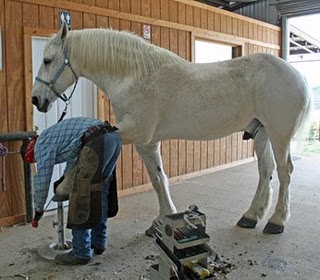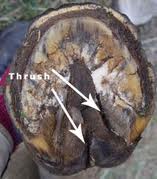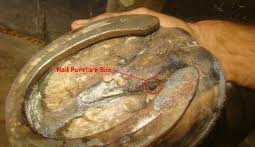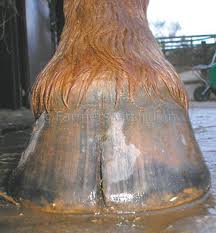|
Hoof CarePick out your horse's feet. This may sound pretty basic hoof care, but it's the single most important thing you can do for his hooves, a surprising number of owners think picking out the feet is the farrier's job. Your horse gets a head start on healthy hooves, and you get a chance to take early action on many common hoof problems, if you pick out his feet...before each ride, to remove any stones or small objects lodged in his feet before you add your weight to the situation, and to check on the condition of his shoes after you untack him, in case something has gotten stuck in his feet during the ride.
Each time you clean your horse's hooves, take an extra couple of minutes after you've pried out any packed debris to gently clear the crevice of the frog, and scrape any remaining bits of matter off the sole, with the tip of the pick. You want to be able to see the sole's entire surface, so finish hoof care with a stiff brush. Some hoof picks come with brush attached, or you can buy a brush separately and inexpensively.
Establish what's normal hoof care. While handling your horse's feet to pick them out, notice their temperature; when everything's OK, they'll feel very slightly warm. Check the frog, which has about the texture and firmness of a new rubber eraser when it's healthy. Most horses shed the frog at least twice a year, sometimes more often. Your farrier's regular trimming of the frog may have prevented you from noticing this natural process before.

Schedule regular farrier visits according to your horse's individual needs. Although six to eight weeks is the average, there's really no standard interval for trimming and shoeing. If your farrier is correcting for a problem such as under-run heels, a club foot, or flare in the hoof wall, your horse may benefit from a shorter interval. If everything looks fine but you notice that he begins forging (striking the back of a front hoof with the toe of a back hoof) in the last few days before his next shoeing, ask your farrier whether a shorter schedule might avoid the problem. Possibly four to five weeks in the summer, slightly longer in the winter. To help your horse grow the best possible hooves you can include supplements to your hoof care. Some horses naturally have better hooves than others. Some hooves benefit from supplements, others show little change. The benefits of using supplement take up to six months to a year to show up in new hoof growth.
Natural trimming is a balanced trim that allows the horse to grow the optimal hoof. Frequent trims (every 4-6 weeks) are very important. Respecting the “healing” angle is paramount. That is the top 1/3 of the hoof. Allowing the hoof to contract and expand naturally is essential to circulation. Diet and lots of exercise are key components. This works for all breeds, from draft to mini. When the shoes are first pulled, there may be some tenderness. The hoof is experiencing the ground for the first time in a long time. Circulation is again returning to the hoof and the horse is actually feeling again. Some horses require boots to make the transition, most don’t. Some severe cases of founder will require booting for the comfort and mobility of the horse. There are a lot of barefoot trimmers out there. A bad one can do more harm than good. Please use only “certified” trimmers.
When picking out the feet, look for signs of... Thrush The first clue to this bacterial condition (usually caused by prolonged standing in manure, mud, or other wet, filthy conditions) is a foul smell and dark ooze from the cleft of the frog. Later, the frog becomes cheesy in texture. Although thrush can eventually cause lameness and significant hoof damage, its early stage is simple to treat. Use an over the counter remedy recommended by your farrier or veterinarian. Keep your horse's stall is clean and dry. If you normally bed with straw, consider a change to much more absorbent shavings. If you think your horse has an early case, ask your farrier to check.

Equine thrush is caused by anaerobic bacteria that, when trapped in moisture, can create a fungal infection that slowly eats away at the horse's hoof tissue, particularly the frog area. Most of the time this will create some mild discomfort, but as long as it is addressed quickly it rarely does anything more. Left unattended for a period of time the thrush can eventually make its way into the sensitive areas of the frog, causing a bit of bleeding from the frog. A hoof that is afflicted with thrush will exhibit soreness, black pus-like liquid as well as a scent that can send a skunk running. If you detect these symptoms you can either attempt to treat it yourself or call a blacksmith to assist you. Since the bacteria that causes thrush is anaerobic a clean environment and air is enough to keep it away.
Even with great hoof care if thrush does manage to creep up on you and your horse, first call your farrier so that he can thoroughly clean and trim the hooves. This will make it far easier for your horse's hooves to aerate, plus you can apply medication more directly to the infected areas. Two products that are highly regarded by farriers for their effectiveness are Kopertox and Thrush Remedy by Absorbine. Thrush can be a dirty, smelly business to deal with, but luckily as long as you do not neglect it your horse will suffer no long-term problems. Of course since thrush is so easy to prevent just by keeping clean stalls and clean hooves, chances are high you'll never once be introduced to this black-hearted monster.

Puncture If a nail or other object pierces your horse's sole and then falls out, the entry wound will probably be invisible by the time you pick his feet and you'll be unaware of it until it causes an abscess. But in some cases the object remains in place, to be discovered when you brush the last bits of dirt from the sole. DON'T PULL IT OUT. Call your veterinarian right away. An X-ray of the foot can show how far the object has penetrated and which structures are involved. Your veterinarian can remove the object and advise a course of hoof care.

Cracks Some cracks are superficial, others can involve sensitive hoof structures, without appropriate hoof care. If you notice a crack in your horse's hoof, call your farrier and describe its location and size so he can decide whether it needs attention now or can wait until the next regular shoeing.
Abscess If your horse's digital pulse feels stronger than usual and/or is foot is warmer than normal to the touch, the cause could be an abscess inside the hoof from a badly placed shoeing nail, a bruise, or an overlooked sole puncture. Your routine hoof care can alert you to the problem so you can get your veterinarian or farrier involved right away. If you find increased heat and a stronger than usual digital pulse in both front feet, and if he's shifting uncomfortably from foot to foot, call your veterinarian immediately. These are signs of laminitis, an inflammatory condition that can cause severe hoof damage and, if not treated promptly, can even be fatal.
Source - Jeff Rolo, hoof care
Return from Hoof Care to Horse Riding Connection
|
